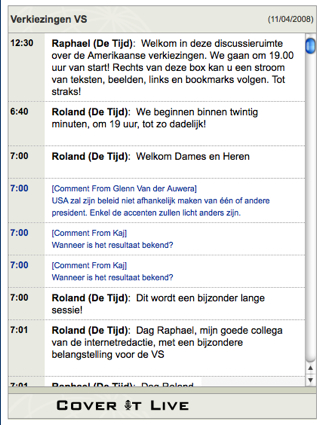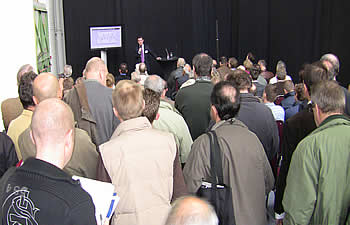Modern newsrooms have to engage in a never-ending conversation with their community. This may sound self-evident, but it can be a tough sell in a newsroom working under high pressure. So how do you get reporters to buy into the proposition that they need to listen to their audience? They need to see for themselves the enthusiasm that the community has for talking back to its reporters.
The people formerly known as the readers have now become readers/writers. In the “good old days” of the print newspaper, we only got a few letters each day. Today, we get hundreds and sometimes thousands of comments on our news articles each day. With the click of a button, readers can easily and instantly post reactions to articles. Furthermore, the readers don’t only react to our articles — they react far more often to each others’ comments. The article may start a discussion, but it does not necessarily remain the center of attention.
This interaction gives us more than additional eyeballs; it teaches us new aspects of storytelling. For instance, a news website is sometimes more about telling a story in a way to bring the community together rather than about providing “hard news.”
Three recent stories published in Belgian business newspaper De Tijd provide good examples of how a newspaper can adapt to its new role as a community center.
The Story of a New American President
The election day in the U.S. was an election night for the people in Belgium. Of course, our newspaper covered the elections intensely, but we were at a loss for what to do during the night. People who were so interested in the election that they would stay up all night would surely watch for the results on CBS or CNN, so what would be the point of De Tijid scrambling to post breaking coverage on its site? Would it not be better to focus on “the day after” and deliver more value by writing detailed analysis about the results?
We thought it over and realized there was something valuable in covering the election as it happened, but it was something beyond scoops and analysis: We could gather the community and facilitate a conversation. Compare it with a soccer game: One can watch it at home, alone, or experience the magic of being all together with fellow fans in the stadium.

That night, we launched our CoverItLive live-blog application and I commented on the election night with our colleague in New York City. Several other colleagues also made guest appearances that night. Most striking of all, several thousand community members also visited our live-blog/chatroom that night to post comments — even as they were, indeed, watching the election results on CNN and CBS.
Even though they were technically getting their news from another source, that did not matter. They wanted more than to just hear the news; they wanted to discuss what had happened, share in the joy (of many) and the disappointment (of a few), and hear what other ordinary people had to say about it. We found that as live-blog hosts we didn’t have to comment all the time, as chatty community members filled the “dead air.” Besides, as soon as you get hundreds or thousands of participants, moderating what others say is sometimes enough to keep you busy.
A Judge Decides
Like so many nations, Belgium has been suffering the consequences of the global financial crisis. The biggest bank of the country, Fortis, had to be urgently sold to the French bank BNP Paribas. Fortis shareholders went into shock as the value of their stocks plummeted and they immediately began to question the government’s response in organizing the transaction.
Inevitably, people went to court.
On the week in question, a judge would deliver a very important ruling on the Fortis sale. The event was structured simply enough: The judge would begin by explaining his reasoning, often meandering in one direction and then another, before finally announcing his final decision. In this type of proceeding, it is impossible to know whether the judge’s monologue will go on for one hour or four.
We had doubts about whether or not to live-blog the event. Why not just wait for the news of the verdict — the only hard, fundamental fact that mattered — instead of having live coverage of the long speech?
Once again, we reasoned that there was a community out there — tens of thousands of people in the financial sector and, of course, many Fortis shareholders and clients. There are a lot of emotions involved in this case; it is the biggest issue in our De Tijd community. We just felt we had to be there, with our community, being their ears and eyes (other events taught us that even streaming video of an event does not change this).
So some colleagues did the live-blogging (Dutch language), while others moderated the community dialogue (community members could react in real time in the chatbox). There was a lot of moderating to do in this conversation — more than 10,000 people attended the session! And they had hundreds or thousands of thoughts and questions to share.
At least as impressive were the reactions after the event. We got numerous responses by chat and email, thanking us by chat or email for the live coverage. It was evident this was not only about reporting the verdict. Although the news value of the judge’s speech may not have been particularly high, it was evident that this was what the public needed to hear. And, even more, they needed it as an opportunity to be heard.
Who Was First?
On one recent weekend, another newspaper ran a story about a huge bridge loan authorized by the Belgian state for Fortis. The newspaper said the loan had been authorized very discreetly. Our website did not run that story, because the very discreet loan was, in fact, not very discreet at all: De Tijd had broken that same story three weeks earlier.
We decided not to run the “new” story for reasons that should be familiar by now: There was no new hard news. In fact, we considered this a non-event. However, our community was shocked. They heard about the news in the other newspaper and yet saw no mention of it on our site, which is often thought of as the leading source of information on the Fortis case.
People started posting the article in the comments section of the site, complaining that De Tijd was “giving up” the Fortis coverage. Some suggested the journalists “gave up” after pressure from high places.
Suddenly, our newspaper found out that it had limited control about what was published on the site: Even if the editorial staff did not run a story, people would do it themselves by posting it in the comments and, more so, add their own conclusions. Suddenly a non-event had become a news story after all.
The editor in chief reacted (Dutch language) immediately. He told our community that his journalists had no intention of abandoning coverage — quite the contrary. He explained that the story about the bridge loan was actually an old story, and linked to the story we had published three weeks earlier.
The Monday after we learned that his reaction was by far the most read story of the weekend. There was a lot of “real hard news” on the site, but for our community the discussion about the Fortis coverage was far more important, even though nothing new had happened there.
Unanswered Questions
After these incidents, many colleagues now seem to accept that engaging in conversations with the community is an important part of our role as a newspaper. The community appreciates it enormously, and it is also the sensible thing to do in terms of encouraging visitors to spend more time on the website.
Of course, this current financial crisis limits the amount of time that reporters can spend fostering a sense of community as those working in the newsroom have other jobs to do. So how can we still make sure that we don’t ignore community development during these troubled times? Some possibilities we are working on include:
> Considering inviting community members to be moderators or else outsource moderation duties.
> Explaining the rules and guidelines for comments clearly and in a positive way.
> Using well-known symbols to make moderation clearer: We give serious offenders a “yellow card,” which means their reactions are no longer published in real time but need prior approval. In extreme cases we give a “red card,” banning them. We do not use these cards for someone who only went off-topic, but for people insulting other participants, for instance, or using repeatedly unacceptable language.
> Buying or developing a system wherein community members can rate comments and filter out those with low marks.
Whatever system we go for, it remains crucial that journalists running a story know how the community responds. Reporters should realize that while not every reader of a business newspaper is a CEO or a PhD in Economics, they can still learn a lot from their community just by engaging them in online conversations.
Roland Legrand is in charge of Internet and new media at Mediafin, the publisher of leading Belgian business newspapers De Tijd and L’Echo. He studied applied economics and philosophy. After a brief teaching experience, he became a financial journalist working for the Belgian wire service Belga and subsequently for Mediafin. He works in Brussels, and lives in Antwerp with his wife Liesbeth.
Illustration of social media by Omar Lee for MediaShift.


It is important to note that “the community” frequently carries conversations in spaces far outside of the journalist’s organization.
Really thats a very good idea and i like it.I think music is relly fundamental for human life to live with happiness.